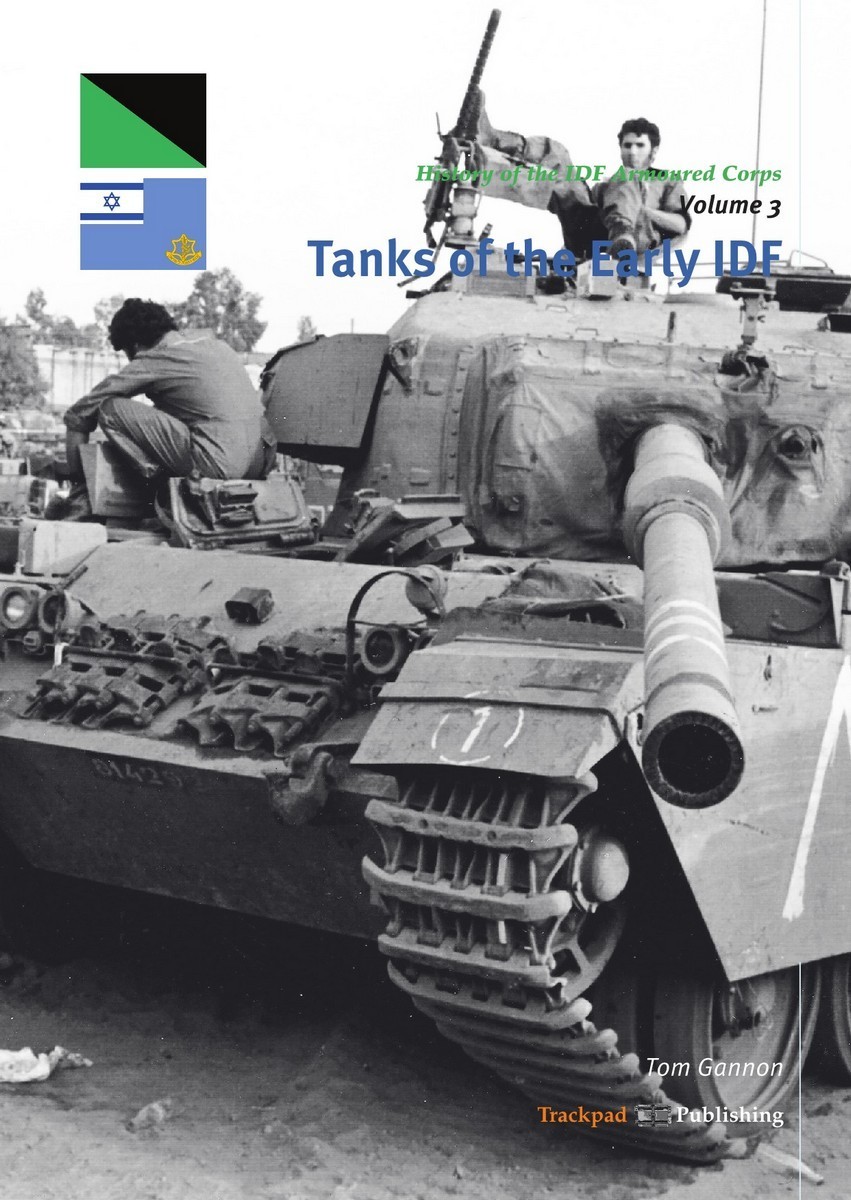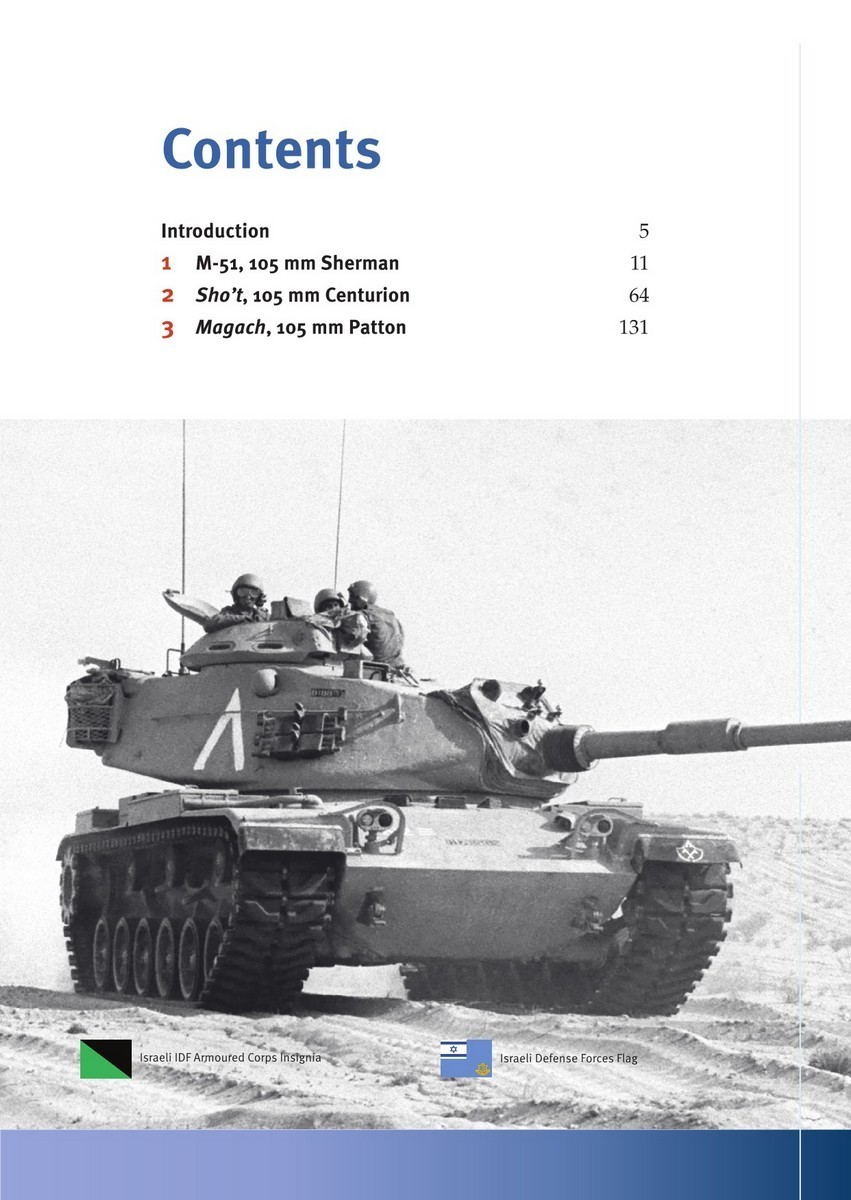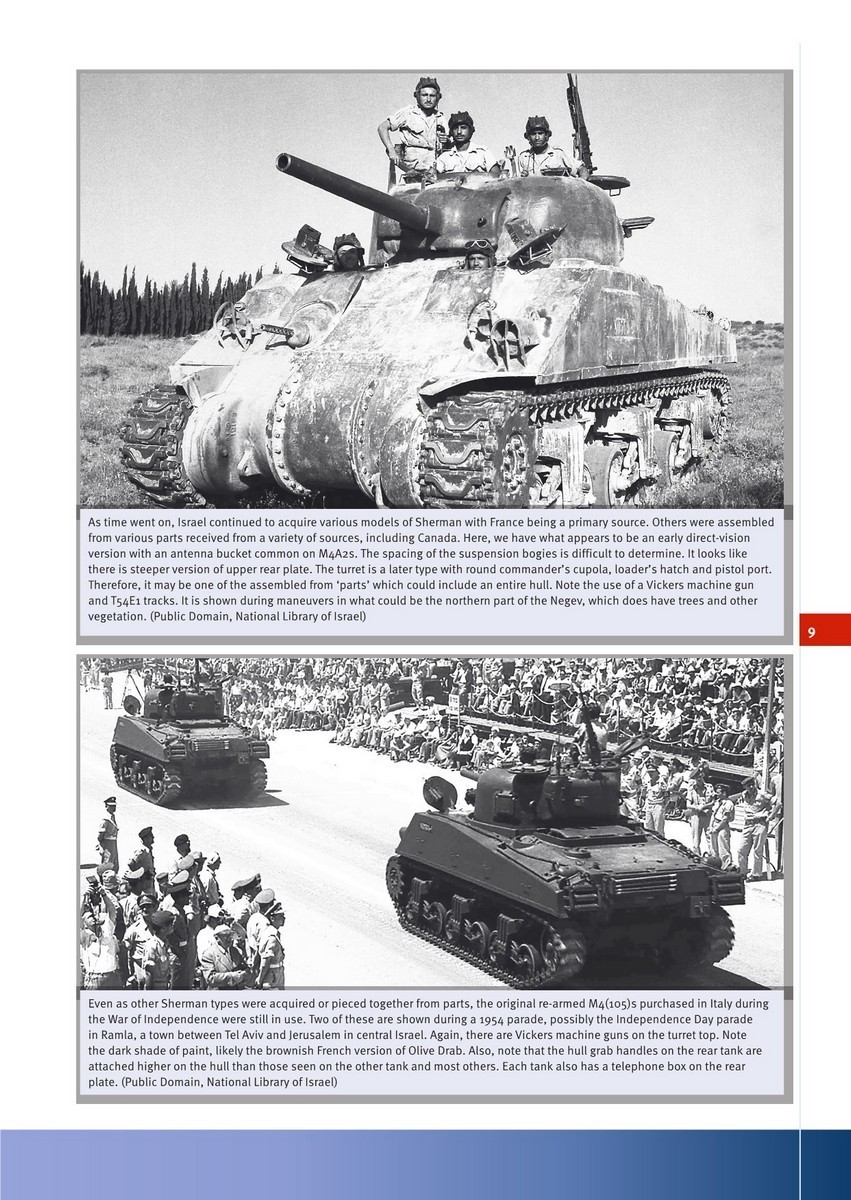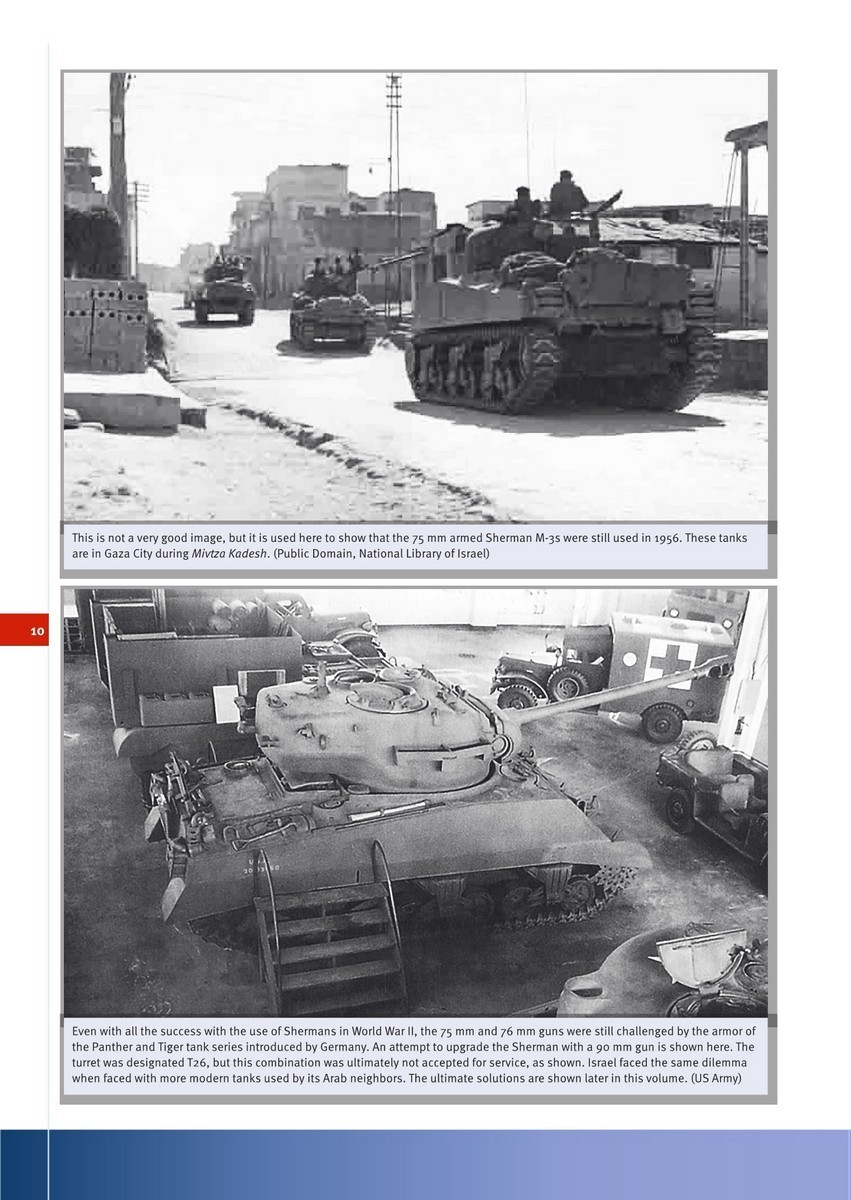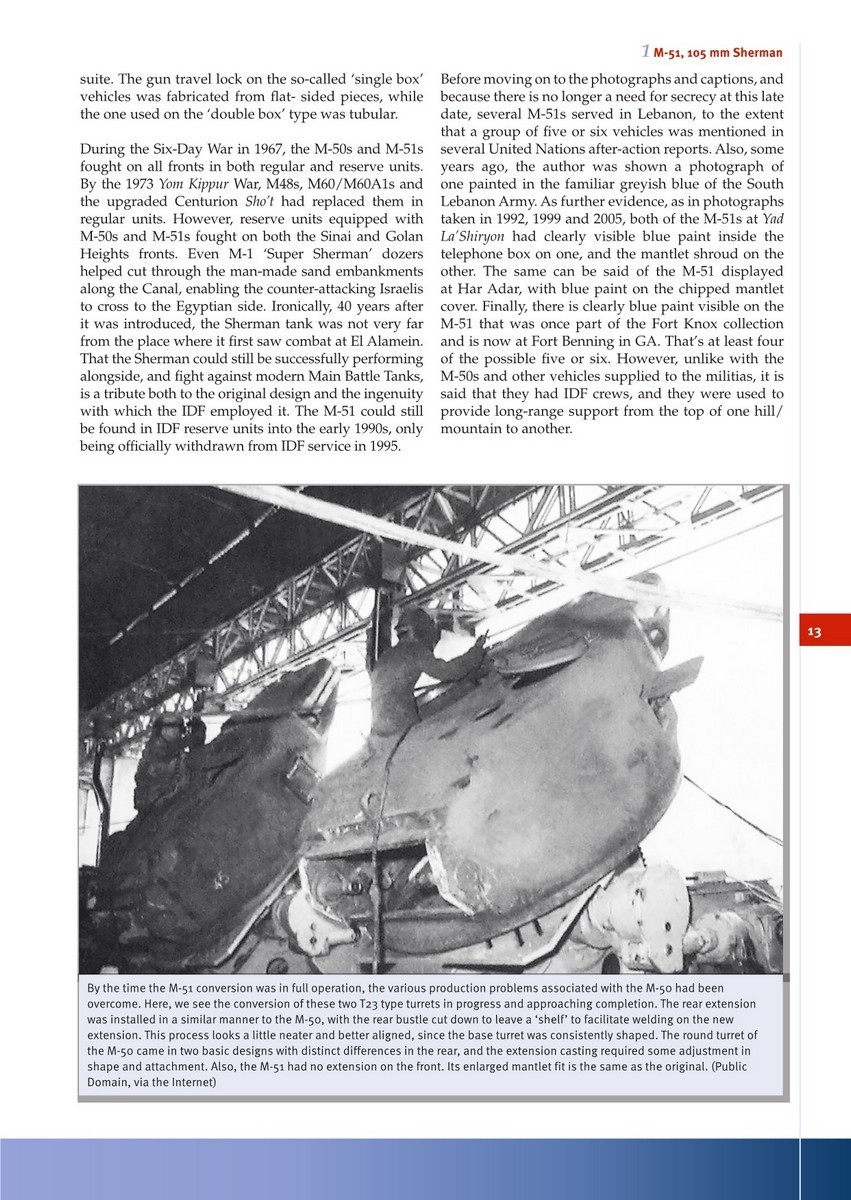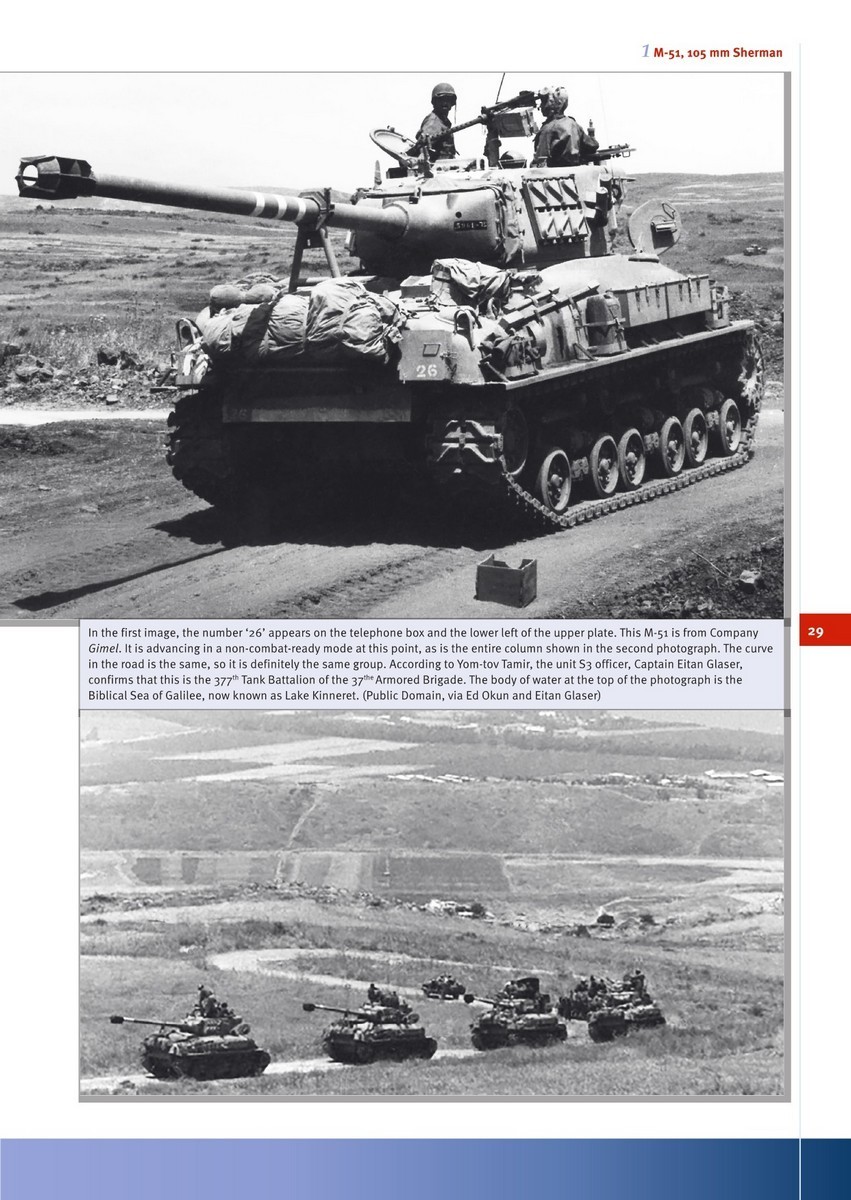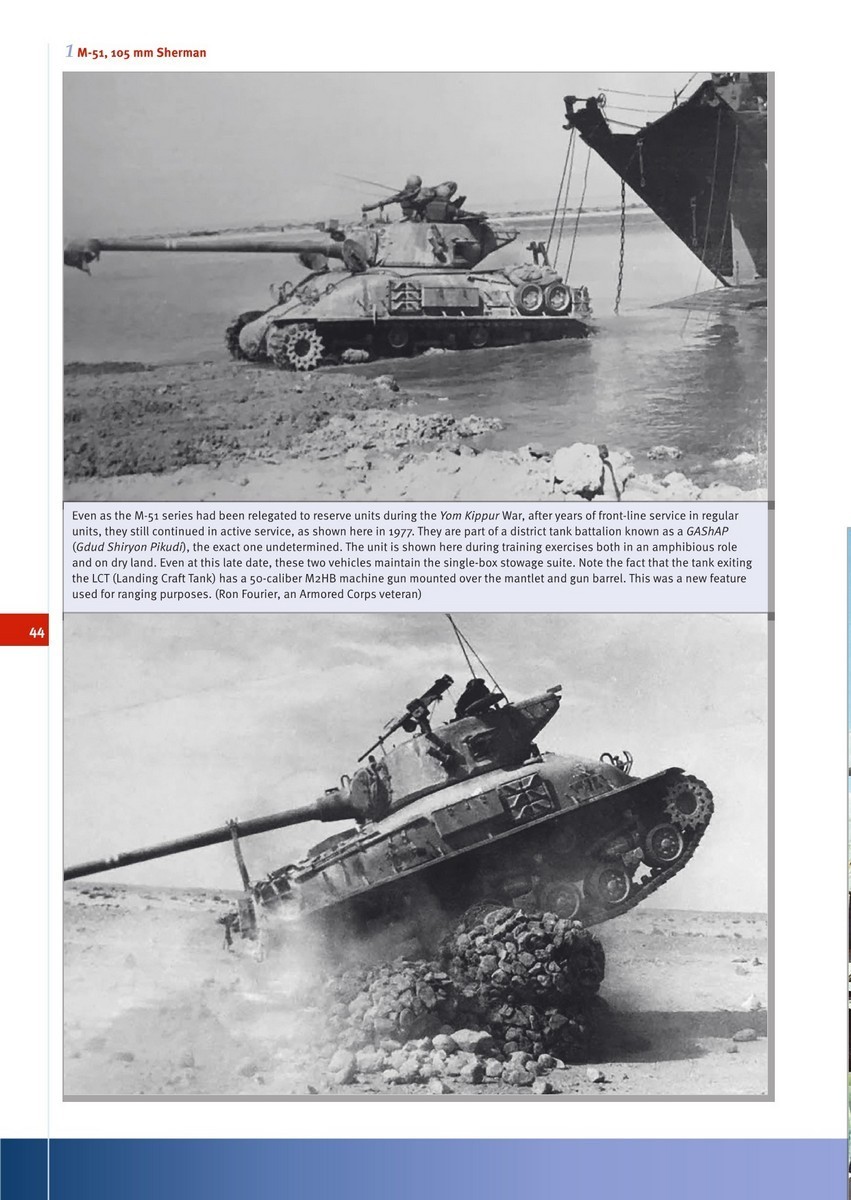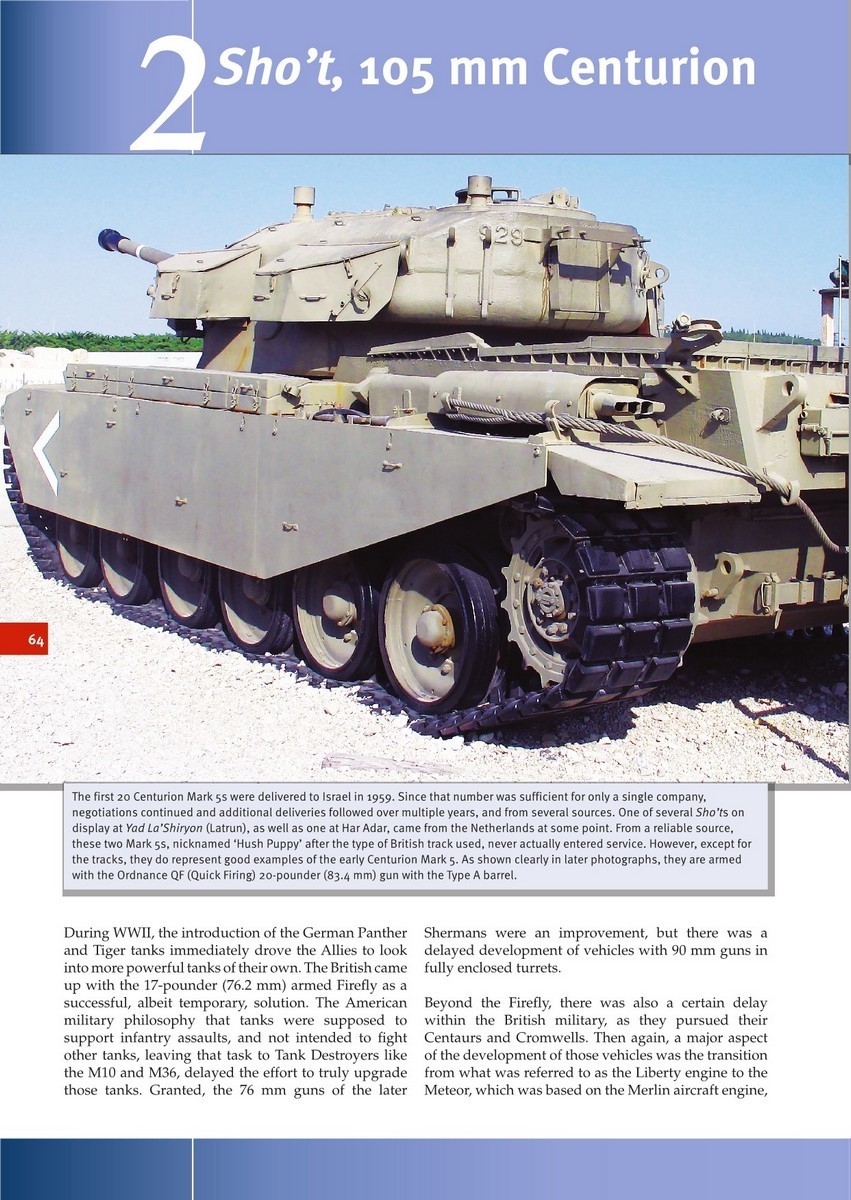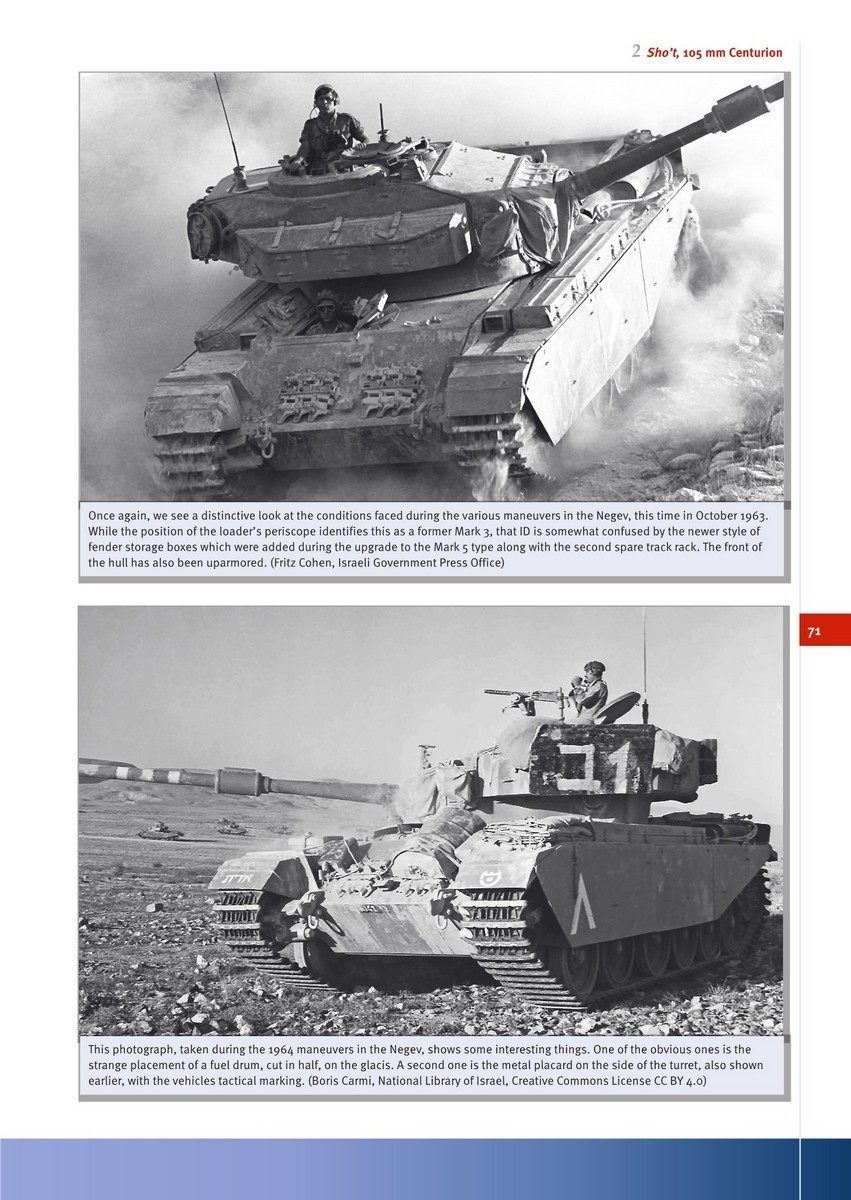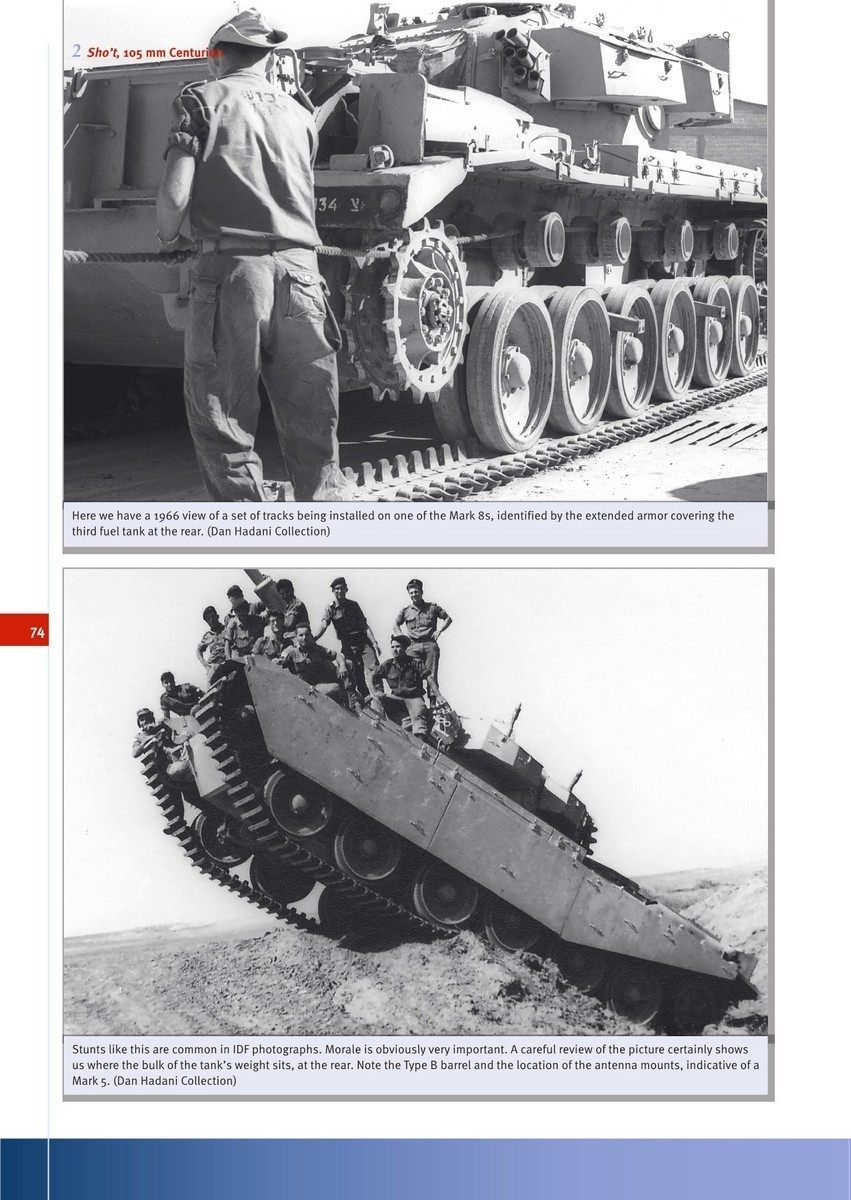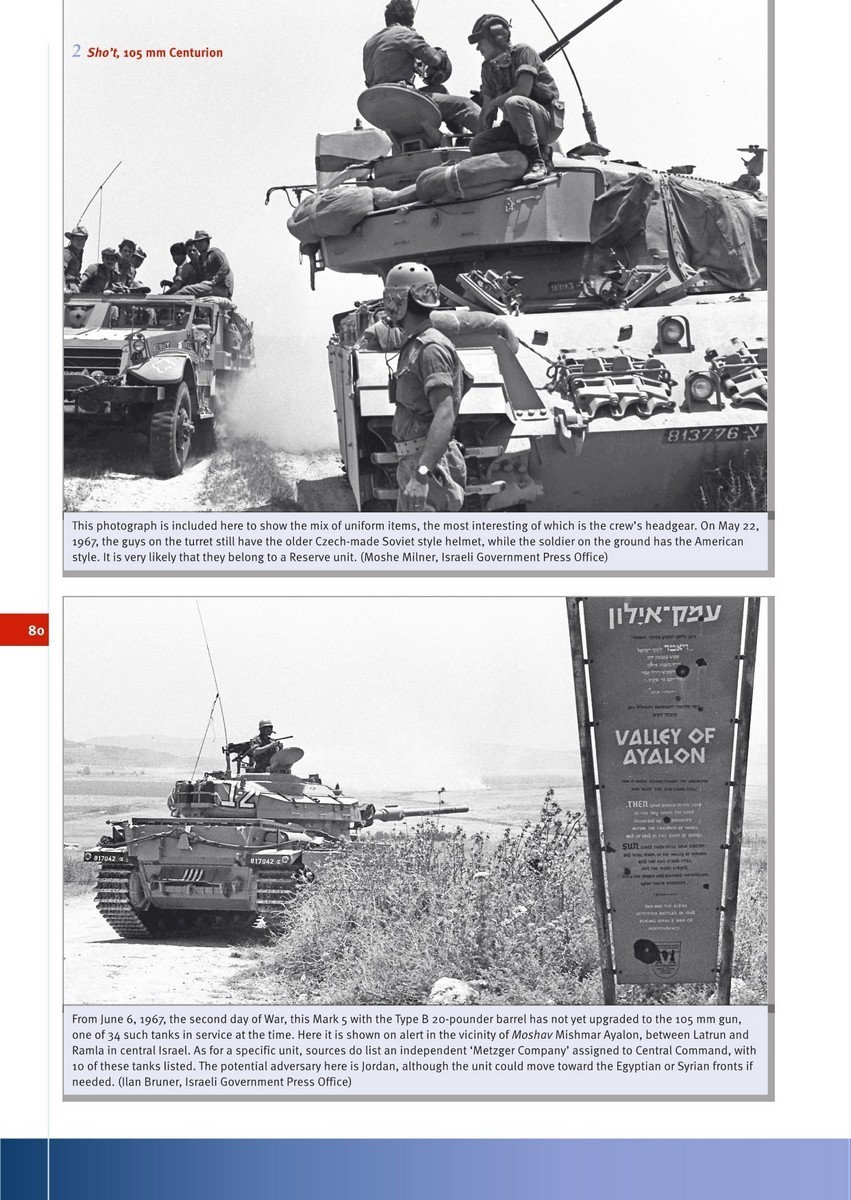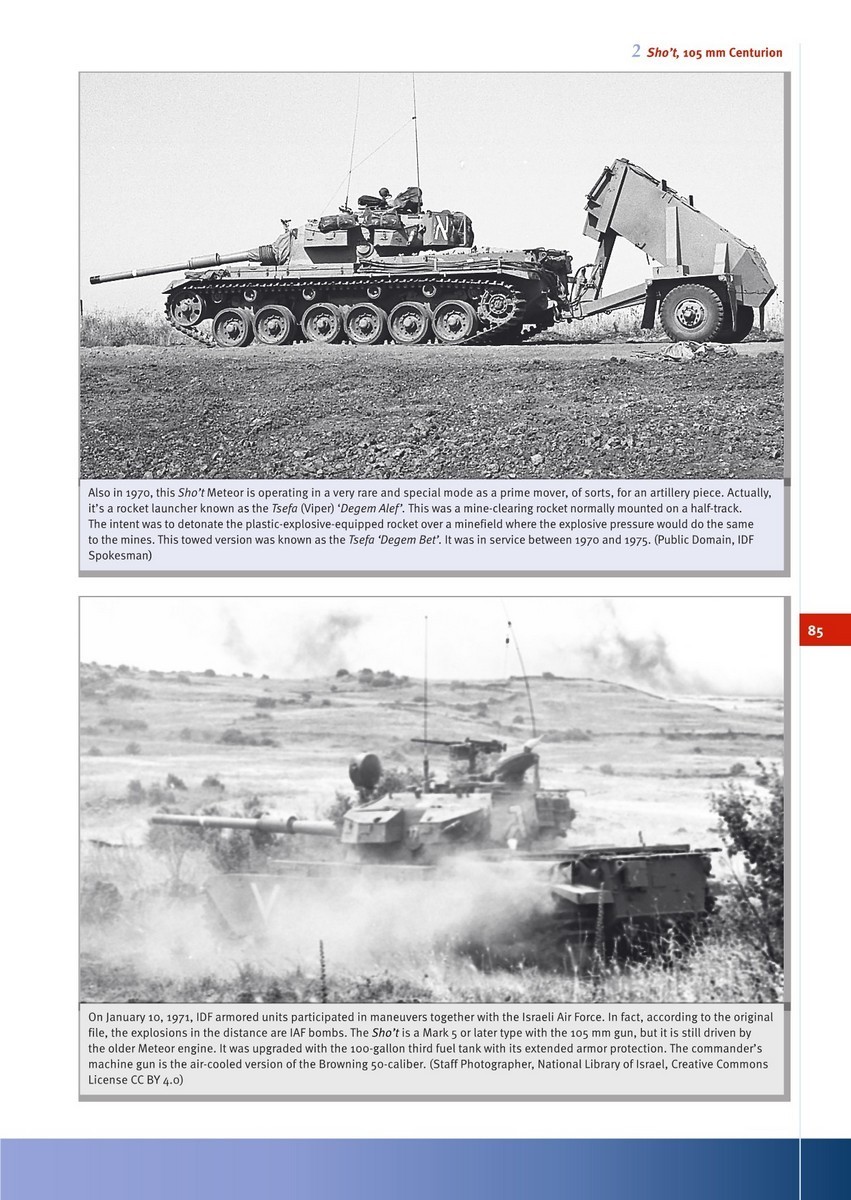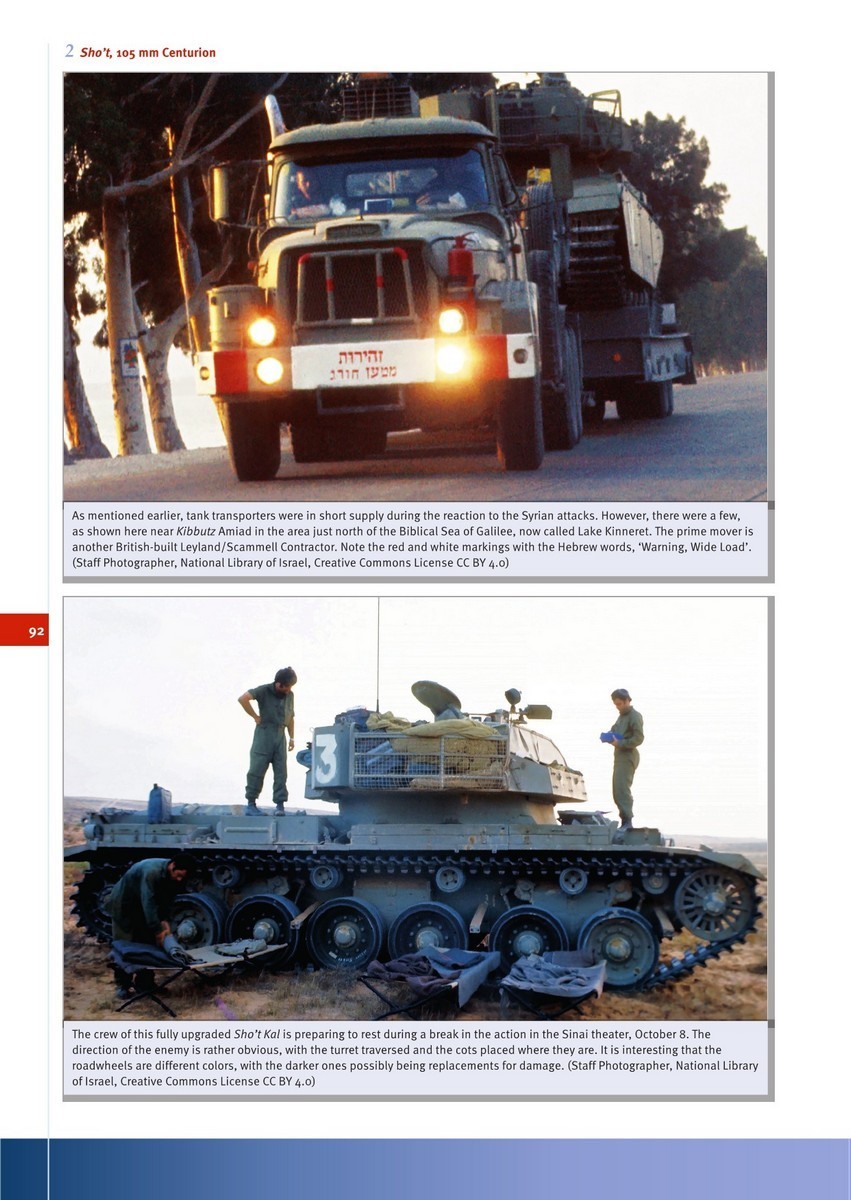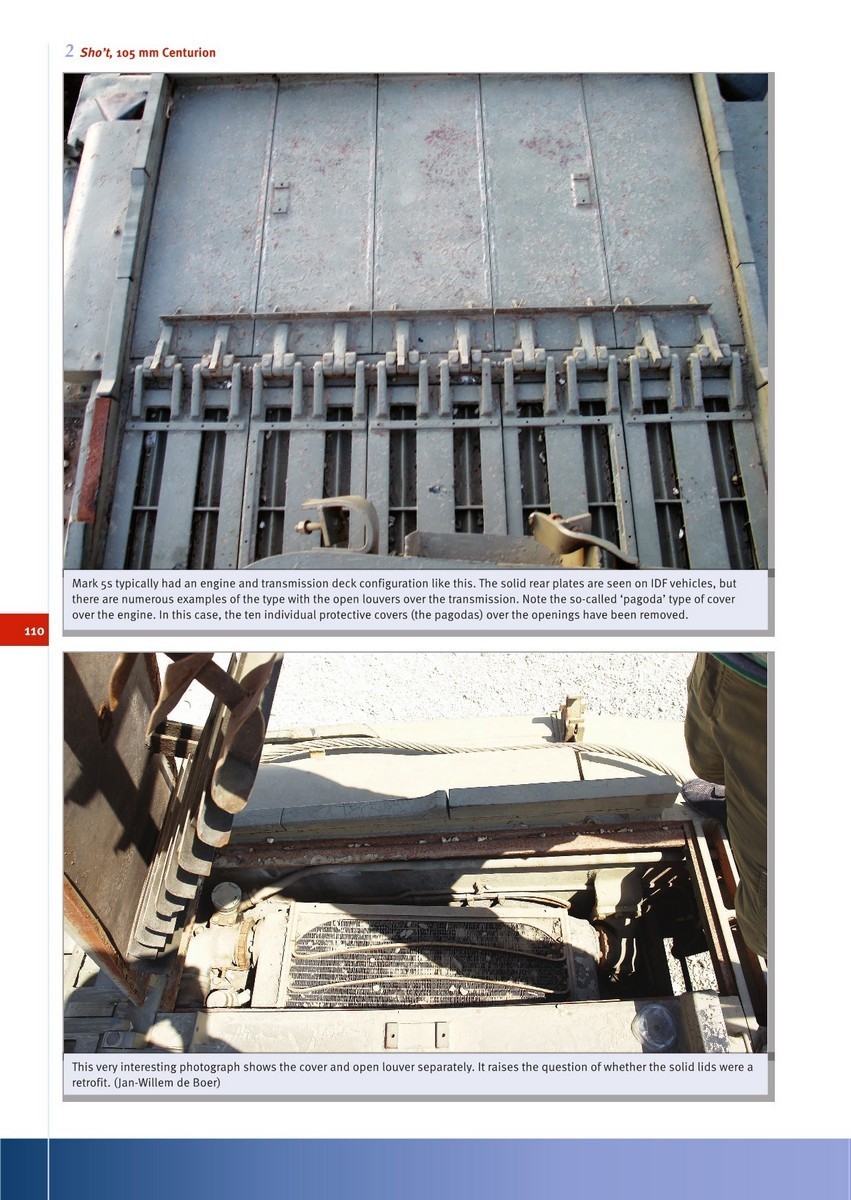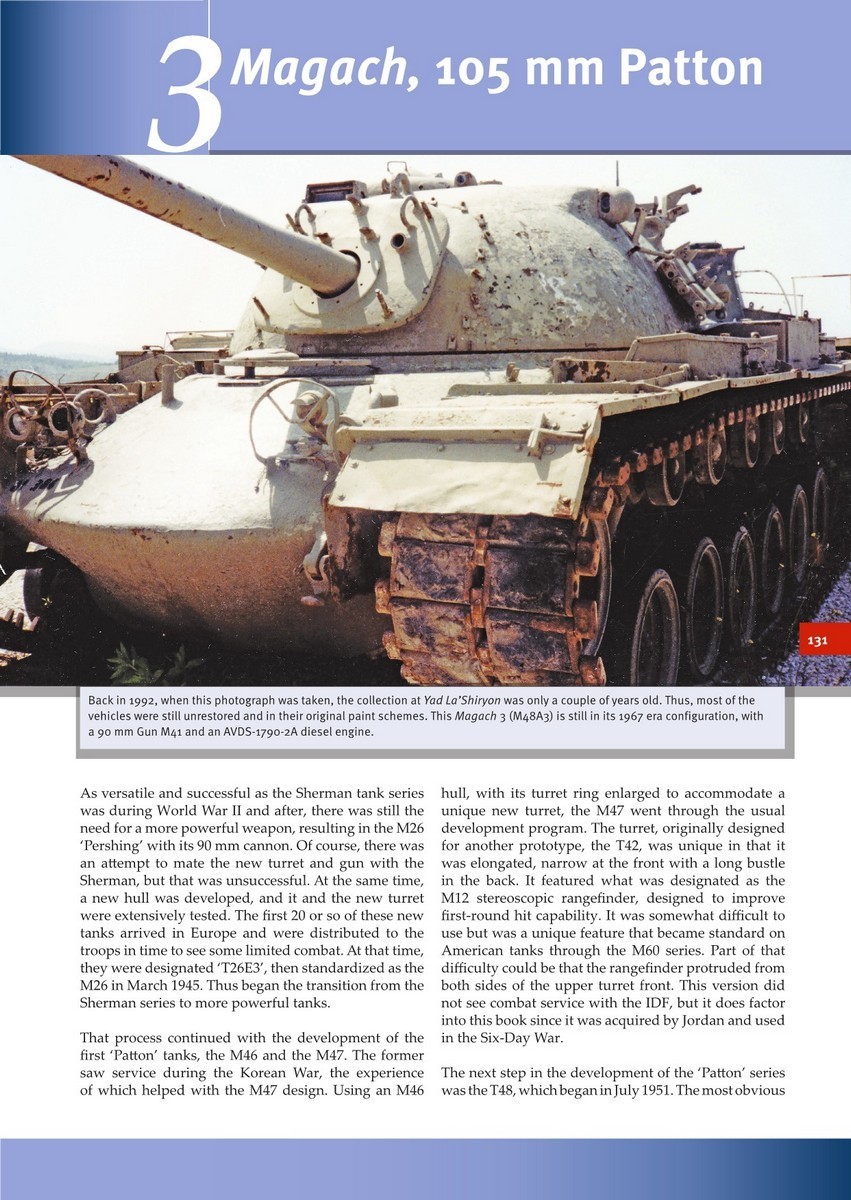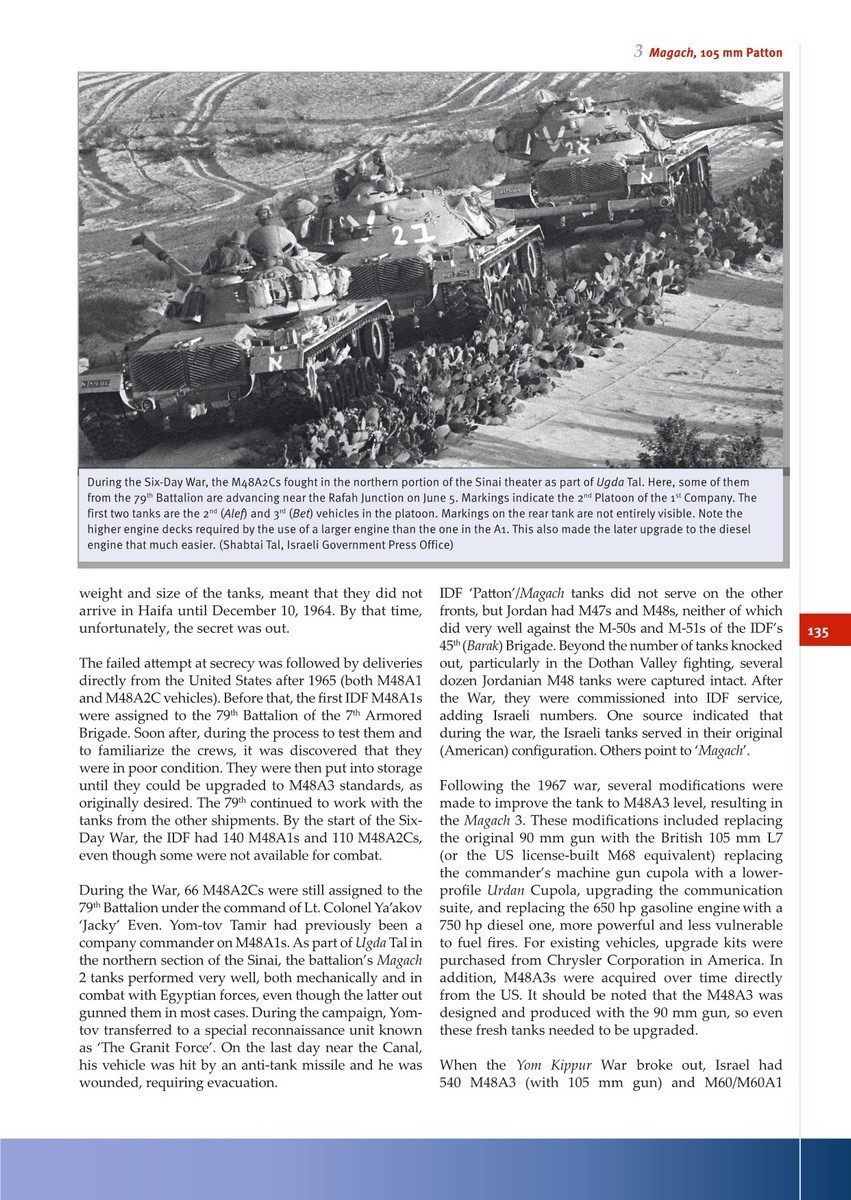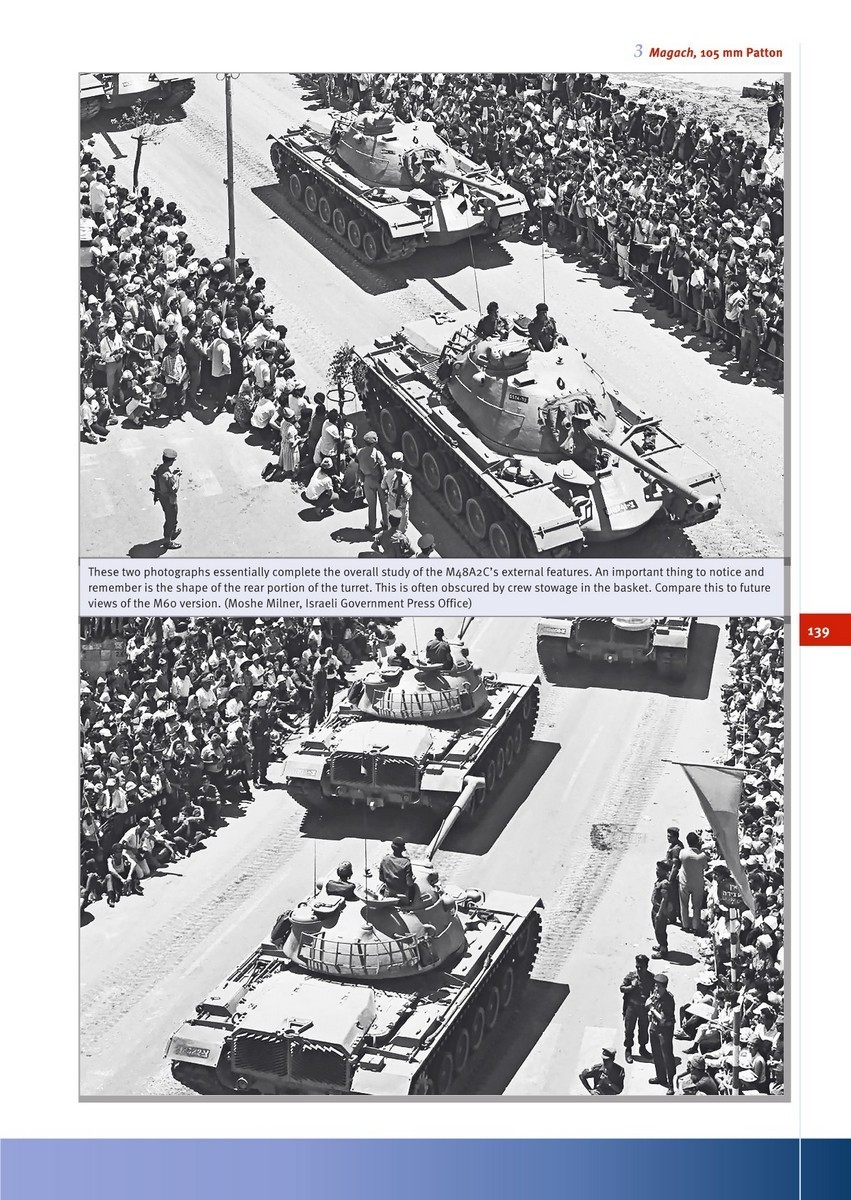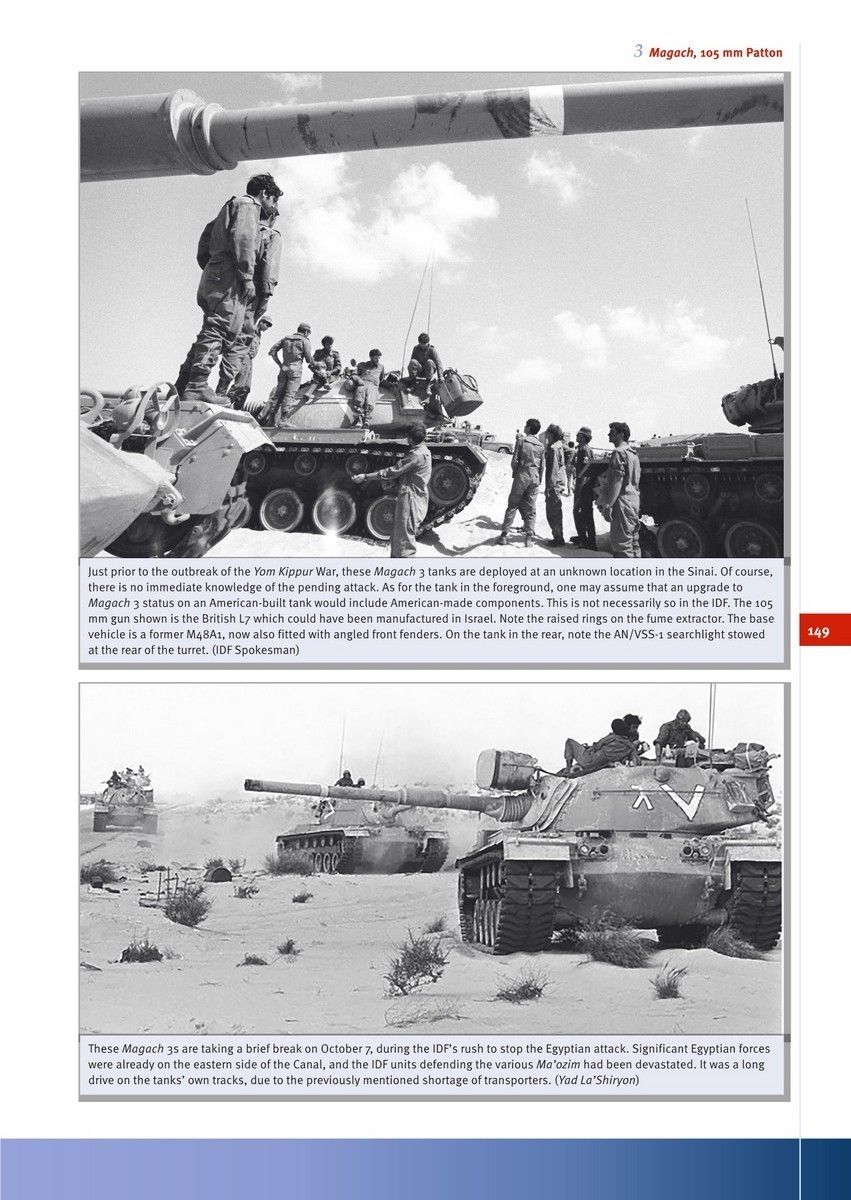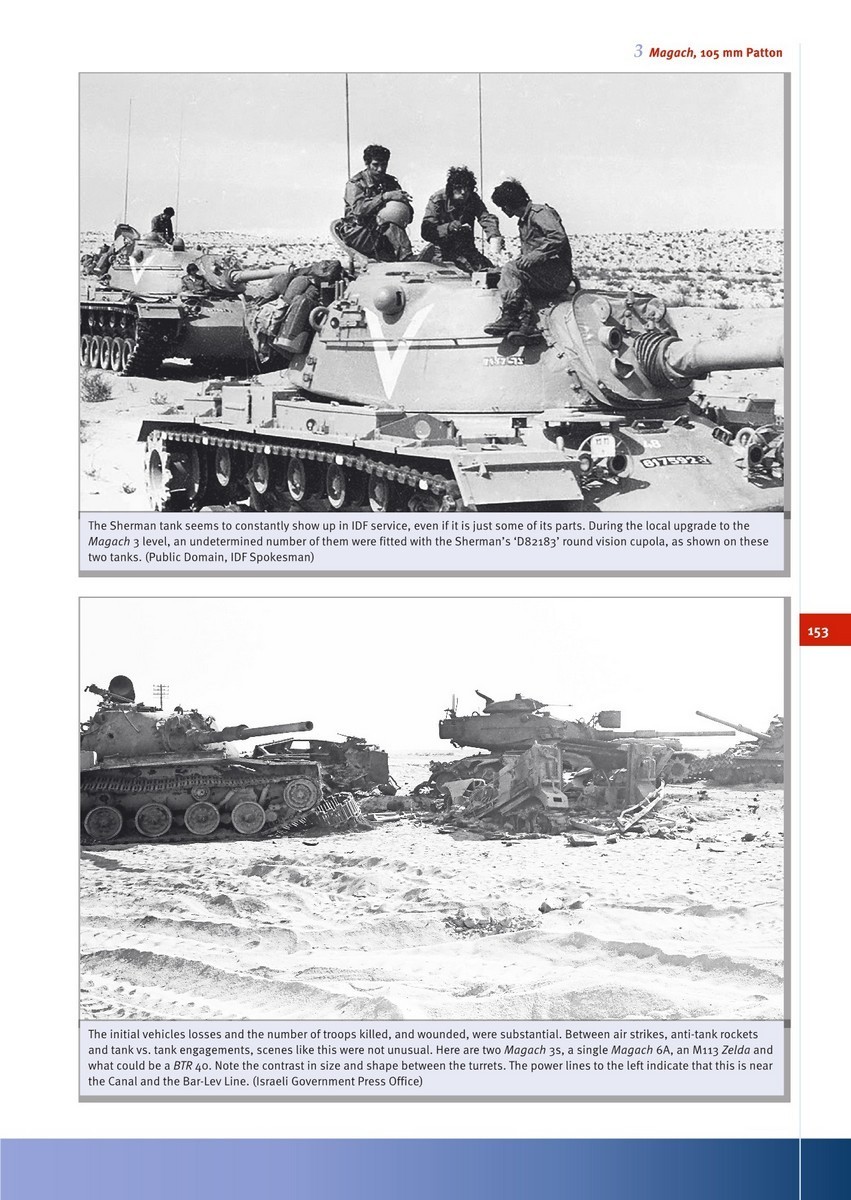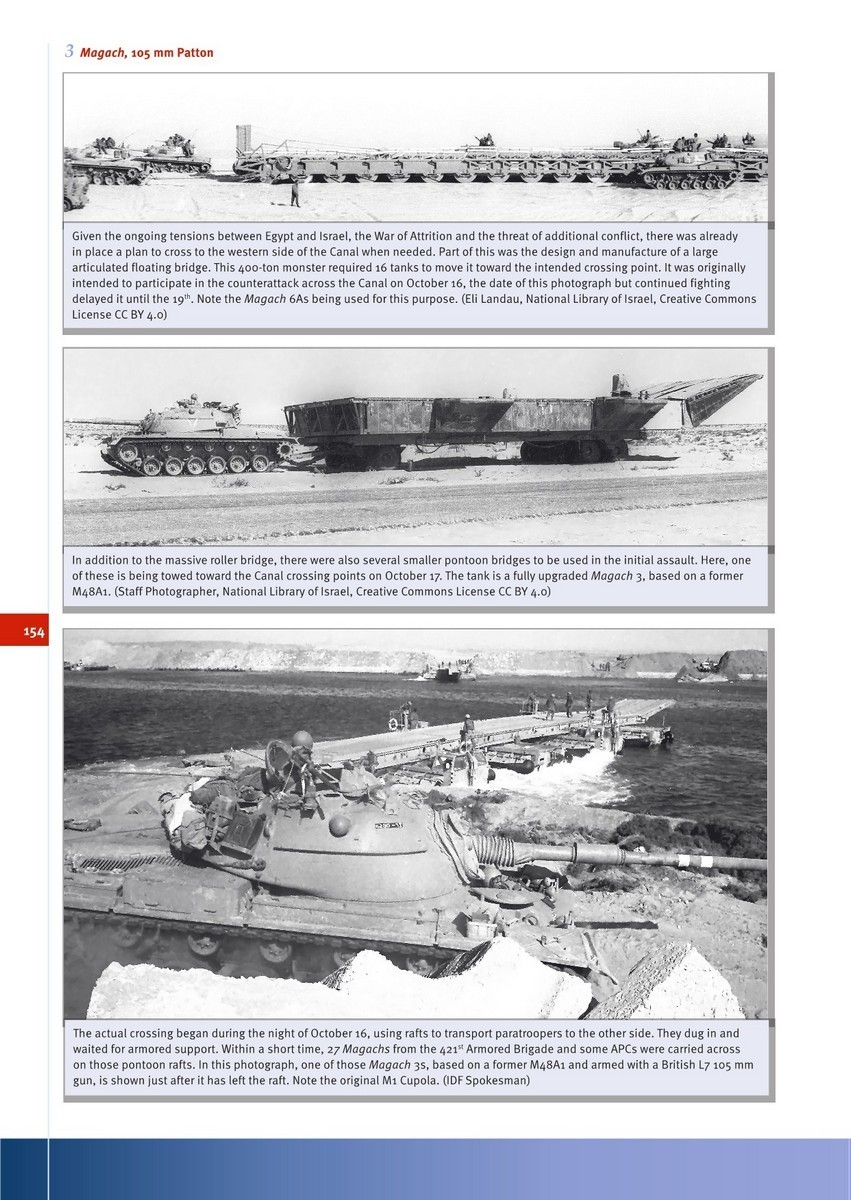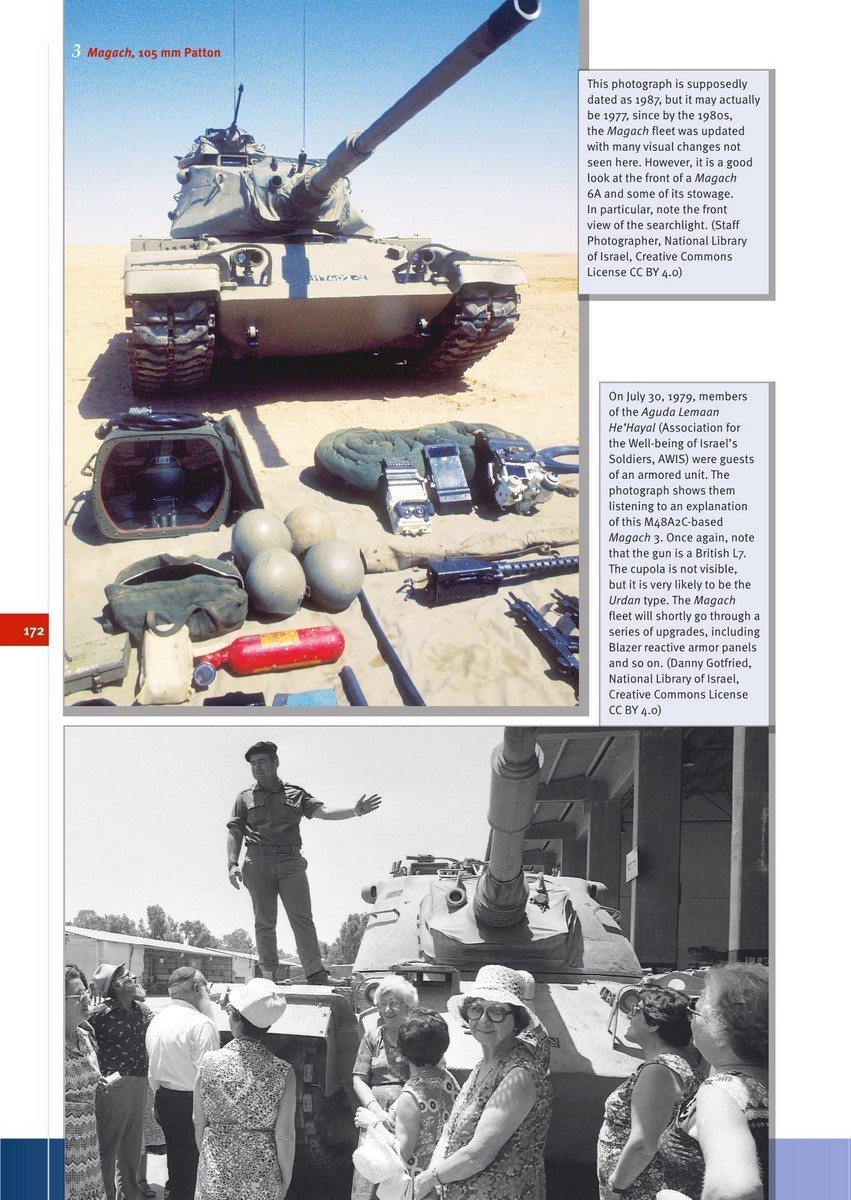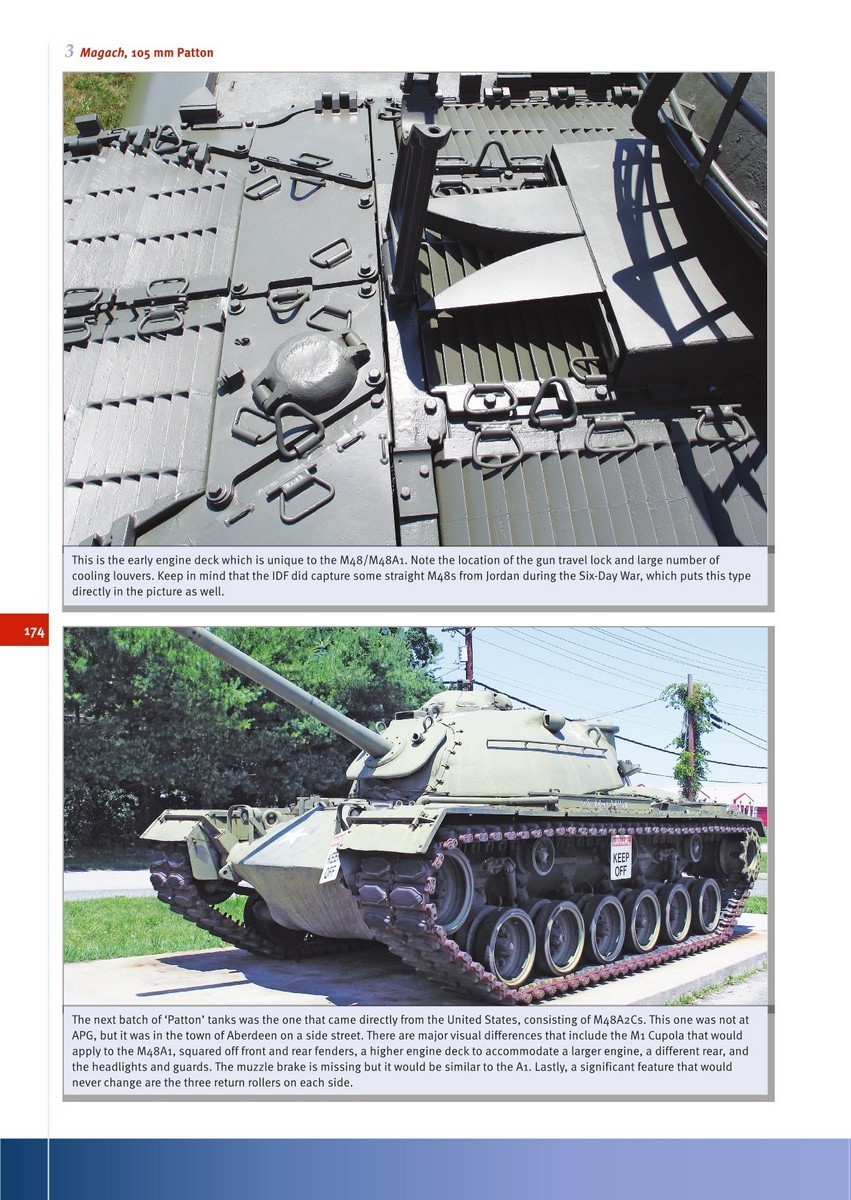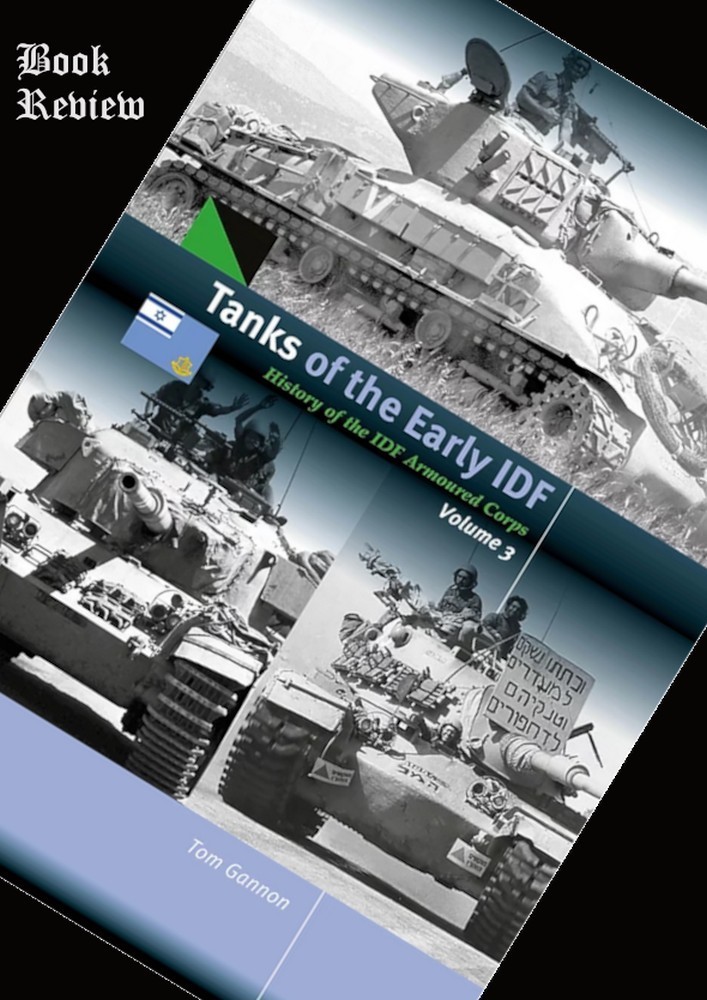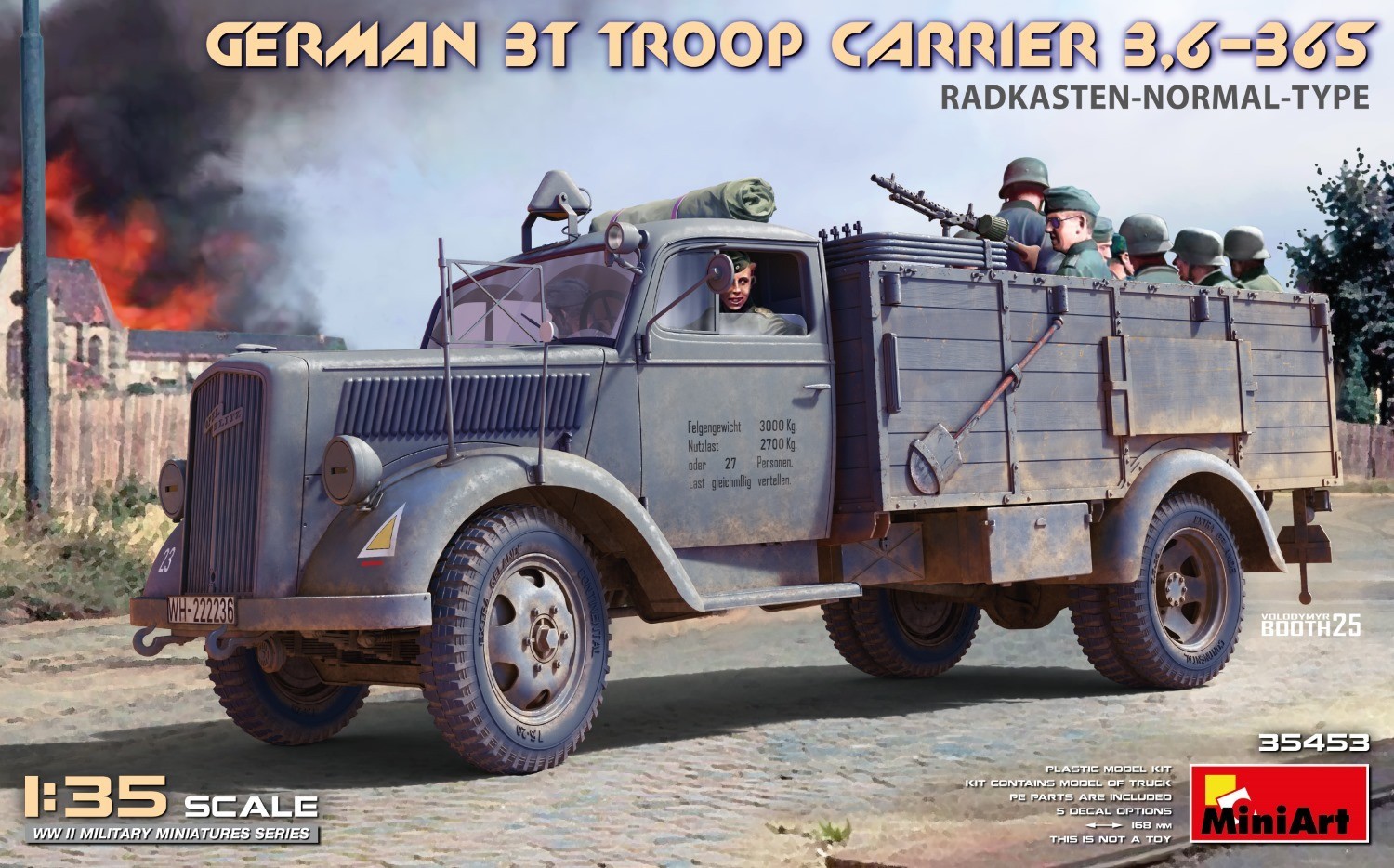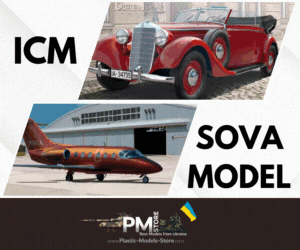Brief history
This volume deals with the M-51, 105mm Sherman, Sho’t,105mm Centurion and the Magach, 105mm Patton.
The young state of Israel was surrounded by Arab nations that were poised to destroy it since the 1930s when the first exodus started. By an order from Defence Minister David Ben-Gurion on 26 May 1948, the Israeli defence forces were created, immediately embroiled in the 1948 War of Independence.
The M-51 Sherman,
The Sherman M-50 and the Sherman M-51, both often referred to abroad as the Super Sherman, were modified versions of the AmericanM4 Sherman tank that served with the Israel Defence Forces from the mid-1950sto early 1980s. The M-51 was also referred to as the Isherman (Israeli Sherman). However, the designations "Super Sherman" and "Isherman" were never used by the Israeli defence Forces. Many different tanks were made from the base of the M-50 and M-51 like the L-33 Ro’em, which is Hebrew for "thunder maker". A self-propelled, the L-33 was adopted by Israeli forces in 1973 and was immediately used during the Yom Kippur war. It was also used in subsequent conflicts. With the introduction of the US M109 howitzer it was quickly relegated to the reserve role. No L-33 have ever been exported.
The L-33 was produced only in one version. All models use the Sherman HVSS chassis with new diesel engine. The large superstructure makes the L-33 very easy to identify. A variant called L-39 with 39-caliber ordnance was developed but never produced.
The Sho’t, 105mm Centurion (Hebrew: שוט, lit. 'whip') The Sho't tank served in the Six-Day War in 1967 and the Yom Kippur war in 1973; one of them, belonging to the 188th Armoured Brigade, was operated by Captain Zvika Greengold, an Israeli tank ace. However, as all tanks in the opening days of the 1973 Yom Kippur war, it proved exceedingly vulnerable to Soviet-made weapons such as the RPG-2, RPG-7, and briefcase Sagger guided missile, weapons which the Egyptians used in large numbers in the crossing of the Bar Lev line. It is estimated that the Israeli armed forces lost up to 40% of their southern armoured groups during the first two days of the war, highlighting the necessity for infantry support to armoured groups, culminating in the Merkava main battle tanks being equipped with rear troop bays.
Magach , 105mm Patton (Hebrew: מגח,"battering-ram") The first M48 Patton tanks acquired by the Israel Defence Forces (IDF) were purchased from West Germany in the early 1960s (M48A1variant), followed by deliveries from the United States after 1965 (M48A1, M48A2C and M48A3 vehicles). Several dozen Jordanian M48 tanks, captured intact during the 1967 Six-Day War, were also commissioned, adding to the 150 already in service at that time. During the war, the Israeli tanks served in their original (American) configuration.
Following the 1967 war, Israel made modified the tank to M48 A3 level, resulting in the Magach 3.
Contents
Introduction 5.
1. M-51, 105mm Sherman 11.
2. Sho’, 105mm Centurion 64.
3. Magach, 105mm Patton 131.
Author Tom Gannon Born in January 1949, the author grew up near Baltimore, Maryland in the United States of America. A business credit manager by profession, his hobby interests include armour modelling and researching Sherman tanks and the Israeli Defence Forces. He is a regular visitor to various Internet armour discussion forums and has presented seminars on armour subjects at model shows in the US.
Publisher Trackpad Publishing History of the IDF Armoured Corps Volume 3 is a softback glued spine book with a pagination of 197
Review
The shortage of tanks also prompted the use of American halftracks converted to carry anti-tank weapons capable of knocking out enemy tanks. Based on the successful use of such weapons in World War II, several ex-British 6-pounder anti-tank guns were installed in the half tracks.
The 82nd Tank Battalion was transformed to the 12th Ha’Negev Brigade in 1949 with a parade at Lod Airport to mark the occasion. Participating in the event were the available truly effective Sherman tanks, including those that fought in the War of Independence. Even as other Sherman types were acquired or pieced together from parts the original re-armed M4-105’s purchased in Italy during the War of Independence were still in use as late as 1954 were at least two of these attended a parade, during possibly the Independence Day parade in Ramla, a town between, Tel Aviv and Jerusalem.
M-51, 105 mm Sherman tank. Initially, it did not seem like Israel would have access to modern MBTs (Main Battle Tanks) to counter the increasing numbers of similar tanks being supplied to Egypt, Syria and Jordan. So, just as with the creativity involved with the M-50 program, a second effort went into what became the M-51.
Again, as with the M-50, the IDF Ordnance Corps worked with French engineers to further up-gun the Sherman using the new 105 mm gun CN-105-F1 mounted in the AMX-30 MBT. A major change was the use of the T23 style turret, rather than the smaller version used in the M-50, to accommodate a gun with a muzzle velocity of nearly 3,300 feet (1,000 meters) per second. Also, the original gun from the AMX-30 was still much too powerful for the Sherman, so the barrel length was reduced by almost five feet (1.5 meters). It was also fitted with a large muzzle brake to further reduce the effect of recoil.
While the first M-50 conversion kits were supplied by France, the M-51 components were obtained locally. The first several dozen turret conversions were done at a commercial plant in Askelon, rather than by the IDF Ordnance Corps. The factory was owned by Ephraim Ilin, a pioneer in the Israeli automotive industry. He was also the man who brought the first clandestine arms ship, Nora (with its cargo of 4,500 rifles and 200 machineguns) to Israel in April 1948. Solely for cost-saving purposes, production was soon moved to Ordnance Corps workshops.
During the Six-Day War in 1967, the M-50s and M-51s fought on all fronts in both regular and reserve units. By the 1973 Yom Kippur War, M48s, M60/M60A1s and the upgraded Centurion Sho’t had replaced them in regular units. However, reserve units equipped with M-50s and M-51s fought on both the Sinai and Golan Heights fronts. Even M-1 ‘Super Sherman’ dozers helped cut through the man-made sand embankments along the Canal, enabling the counter-attacking Israelis to cross to the Egyptian side. Ironically, 40 years after it was introduced, the Sherman tank was not very far from the place where it first saw combat at El Alamein.
That the Sherman could still be successfully performing alongside, and fight against modern Main Battle Tanks, is a tribute both to the original design and the ingenuity with which the IDF employed it. The M-51 could still be found in IDF reserve units into the early 1990s, only being officially withdrawn from IDF service in 1995.
As with all Track-pad publishing books it is a picture heavy book and contains some amazing pictures like the picture on page 13 showing the conversion of two turrets type 23 in the progress and approaching completion. However, I am glad it is the IDF engineers doing the work with the turrets in a forty-five-degree angle, the rear of the turret pointing precariously towards the sky with an engineer sat in the commander’s copula leaning forwards while welding!
Another stunning picture is two long lines of tanks lined up either side one another these were the first M-51s assigned to the 52nd Tank Battalion of the famous 7th Armoured Brigade, which also operated M-50s at that time.
Another picture of note is on page 24, were M-51 Degem Bets are advancing in the Sinai Desert kicking up sand and dust as they power their way through. There are three five tanks in this picture if you look hard enough.
Further pictures appear on the following pages as you go through the book, this follows with the close-up shots which I refer to as the walk around types but also hi-light the amount of detail allowing you to be able to replicate your model realistically.
2 Sho’t, 105 mm Centurion
This was the chapter of this book, I was looking forward to, for me growing up within a family of war veterans so much talk ironically was about the Centurion when most not all, but most were flyboys in the RAF. The Centurion was to all extent and purposes, was quite possibly one of the best tanks produced which saw long service when first used in 1945 and still seeing combat on the front lines into the 1980’s. Looking at the Israelis use and ingenuity made it one of those tanks that played many roles, which of course made it an important acquisition for them.
Initially considered to be a temporary design, pending something much more powerful, the Centurion series quickly evolved into the Mark 3 which was armed with a new 20-pounder (83.4 mm) L/66.6 gun and powered by an upgraded version of the Meteor, designated Mk.4B. This was the first of the type to see combat, serving in action in Korea, starting in 1950.
As we explore through chapter 2 and the Centurion in service with the IDF it becomes clear to just how good an acquisition this became for them and as the marks of Centurions became better so more purchases were made with a picture of a parade in which it shows the second purchase of 18 Mark 8s with several other recognisable new features. The first colour picture of the Centurion at the 1965 parade was held at Tel Aviv. This shows the colour Sand Grey a topic that has been discussed in many forums and books, still to this day people argue over the colour. An impressive picture on page 74 which I believe is a stunt to boost morale is still a very impressive sho’t,
I have said many a time just how good these books are with a ton of pictures at your hand to be able to use for a diorama, historical location or build, or perhaps just to improve your build of an Israeli IDF Sho’t, Centurion.
From June 6, 1967, the second day of War, this Mark 5 with the Type B 20-pounder barrel has not yet upgraded to the 105 mm gun, one of 34 such tanks in service at the time. Here it is shown on alert in the vicinity of Moshav Mishmar Ayalon, between Latrun and Ramla in central Israel. As for a specific unit, sources do list an independent ‘Metzger Company’ assigned to Central Command, with 10 of these tanks listed. The potential adversary here is Jordan, although the unit could move toward the Egyptian or Syrian fronts if needed.
Page 91 sees a fully upgraded Sho’t Kal on a road somewhere on the Golan Heights.
Page 92 As mentioned earlier, tank transporters were in short supply during the reaction to the Syrian attacks. However, there were a few, as shown here near Kibbutz Amiad in the area just north of the Biblical Sea of Galilee, now called Lake Kinneret. The prime mover is another British-built Leyland/Scammell Contractor. Note the red and white markings with the Hebrew words, ‘Warning, Wide Load’. There is another picture showing some tanks were simply beyond any repair, Sho’t kal was totally blown apart on the Golan. My last picture I singled out for a mention was the one on page 98 Following the successful crossing and subsequent battles, Sho’t Kal reinforcements are moving across the pontoon bridge, as several Magach tanks guard the other side. There were multiple such bridges in place, and shortly, the Israelis will build a permanent causeway. A stunning picture which says a thousand words.
Of course, the generous number of pictures that show close up detail and walkarounds is another fantastic Trackpad publishing signature mark with their books
Chapter 3 Magach, 105 mm Patton
As versatile and successful as the Sherman tank series was during World War II and after, there was still the need for a more powerful weapon, resulting in the M26 ‘Pershing’ with its 90 mm cannon. Of course, there was an attempt to mate the new turret and gun with the Sherman, but that was unsuccessful.
The next step in the development of the ‘Patton’ series was the T48, which began in July 1951. The most obvious visible difference is the use of an elliptical turret, with a low-profile commander’s cupola, intended to provide better ballistic protection. Testing was done on several prototypes at Aberdeen Proving Ground and at Fort Knox. Because of the Cold War circumstances, full production of what was still designated as the T48 began in early 1953. After numerous changes were made during that production process, the design was finally standardized as the M48 on April 2, 1953, at which time it was also officially named ‘Patton’.
Given the haste with which this tank went into production, additional deficiencies presented themselves, including a driver’s hatch that was too small for adequate access/egress, and a redesigned commander’s cupola. While there was some crossover during production, just as during the WWII Sherman production program, the tank with a larger driver’s hatch and what was designated the M1 Cupola were standardized as the 90 mm TankvM48A1 in 1954. Visually, except for the hatch and cupola, the two types were very similar in appearance. Two other features differentiate these two types from the next model, five return rollers per side, and a relatively flat engine deck.
As with all of these Trackpad books being picture heavy it makes the understanding of these tanks and how they were changed and put to use which is done in a way that is different from the many other titles that I have read and or reviewed over the last 10 years or so.
The first colour picture of the Patton tank relates to a major achievement of the Six-Day War for Israel was the reunification of Jerusalem, so a portion of the parade was held on the eastern side of the Old City. In this photograph, these Magach 3s are passing the Old City walls. Important features to note are the five return rollers and earlier head light guards which represent an upgrade to the M48 A3 level from an M48 A1. It has an Urdan cupola and the American M68 version of the 105 mm gun. Note that the fume extractor has smooth edges, unlike the original British
L7, which has raised rings. Also, the colour is a yellowish sand. Cupola and the American M68 version of the 105 mm gun.
Another picture of note is two views of the same Magach3 as it’s unit, most likely the 421 st Brigade is withdrawn back across the permanent bridge on February 21, 1974. Having been the first armoured unit to cross the canal the other way, it is perfectly reasonable to be happy to go home. As part of that, this crew has adopted an old quote, to read“and they shall beat their weapons into mattocks and their tanks into earth movers” the first picture shows the brigade heading to the bridge, while the second shows this tank on the bridge crossing the canal on its way home.
Female soldiers have a long history in Israel, going back to PALMACH, and prior. Today, among the other roles, they are instructors in every branch of the IDF, including Armoured Corps, as seen in these two pictures also show a Magach 6 with some nice details of the mantlet and glacis. The female soldiers in both pictures seem to be both happy and smiling.
One of the last colour pictures before we reach the close-up pictures and walkarounds is a photograph is supposedly dated as 1987, but it may actually be 1977, since by the 1980s, the Magach fleet was updated with many visual changes not seen here. However, it is a good look at the front of a Magach 6A and some of its stowage. In particular, note the front view of the searchlight.
We now reach the part of the book that I know a lot of modellers will be using for accuracy in the build of there own tanks. Some of the pictures will be ones not seen in any other books prior and give some amazing shots of Magach’s especially the internal shots showing different stowage of armour, electrics, radio equipment and turret.
Conclusion
As I have said many times when it comes to the IDF I am quite biased as I have a passion for the IDF/IAF and their ingenuity to buy certain tanks and change parts, manufacture better parts and makes the best of anything they have. Some countries spend millions on the latest technologies to up grade a tank or plane and there are no guarantees that the million pounds spent will ultimately prove to be the next big thing, we all know of the failures and bureaucracy around some of these things. But the Israeli people thought about this and did many different work arounds like changing a gun from one tank to a bigger and more powerful one which would also include upgrading the turret with extra weight to counter the power and extra weight of a heavier gun. Eventually they were able to build their own tanks and have their own industry starting from the different countries that they bought these tanks to the design Merkava’s tank was developed in the Merkava and Armoured Combat Vehicles Division of the Israeli Ministry of defence, and most of its parts are manufactured in Israel. Can only be described as incredible, the amount difference from those early days at the end of World War 2 to now it has always been a force to reckon with but now it is a true force to reckon with one that now trains different countries in urban warfare!

